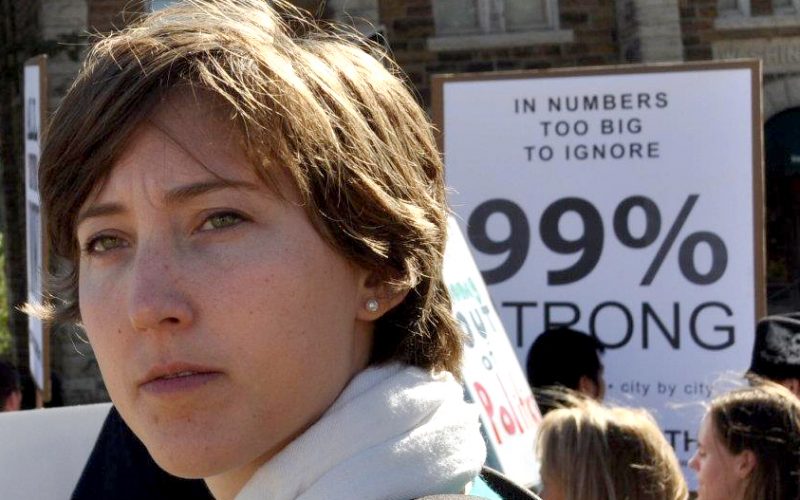“I see this movement as a movement of movements…I think it’s really about grassroots democracy. I think it’s about people trying to create ways of expressing themselves politically because they feel that the electoral channels are closed to them.” — Professor Heather Gautney, Fordham University (via CNN)
Searching through the Occupy NWA Facebook page for a glimpse into the movement is like looking through a history book recounting many grass roots protest movements of the past. Many people joined to have their say, sharing and disseminating information, with high hopes for a movement that might finally change what they see as the broken American infrastructure — wrought with corporate control and human indignity.
Nationally, the system they were fighting stopped being patient, started fighting back with mace and riot police, and many of the disenfranchised protesters began to lose faith in the success of the movement. And locally, the movement began to crumble from the inside, with administrative arguments and disagreements and some illnesses that led several active members to pull their involvement. What once was a shining light at the end of the tunnel became a slow moving train limping down the tracks, pulling against the chains of egotism and a system set up to hide the very information they were trying to spread.
The local movement began at the same time as many around the country. On Oct. 5, the group held their second meet-up of occupiers to make signs, chants and to finalize a mission statement. That mission statement would prove, like that of groups around the country, to be one of the largest detriments to the sustainability of the movement.
“It is the same issues that came to bear on Occupy Wall Street. It’s a very difficult thing to have people get a broader picture when a lot of the influences around them are set up to keep that information from being something they have access to,” said one ONWA member David Druding.
Throughout the month of October — one month after the first OWS protest in New York City — local members were rallying support, supplies and holding regular General Assembly meetings. Their first march was held Oct. 15 and an estimated 450 people were in attendance.
Later, some of the members gathered enough support to travel to NYC to support the national movement, and gain perspective on what was happening.
 Shortly after their departure on Oct. 23, protests around the country were being invaded by local police forces, with atrocities such as the critical injury of Marine war veteran Scott Olsen in Oakland, Calif. It was gaining momentum and attention, but still only a handful of U.S. citizens seemed to truly support and understand what the goals of Occupy were.
Shortly after their departure on Oct. 23, protests around the country were being invaded by local police forces, with atrocities such as the critical injury of Marine war veteran Scott Olsen in Oakland, Calif. It was gaining momentum and attention, but still only a handful of U.S. citizens seemed to truly support and understand what the goals of Occupy were.
Upon the return of the ONWA members from NYC, they found the local group planning for what would be their largest marches, where at their height about 500 local NWA citizens were in attendance. On Nov. 12, these concerned citizens marched through the streets of Fayetteville, holding signs that read “Dissent is patriotic” and “For Sale: America.”
This meeting of community to address broad issues and to bring them to the
attention of the public at large is exactly what the movement was about, said one of the youngest members of ONWA, Olivia Hines.
“People very often forget that this movement sprung up like a weed in the cracks, simply overnight without any planning … it gave people a reason to come together. There is nothing more special than that,” she said.
The group came together one more time to hold a physical occupation of the Fayetteville Town Center beginning on Nov. 12, 2011. The city announced they would not stop the occupation and members began to feel again that this central location could bring back the interest. But by the middle of December, the City of Fayetteville evicted the group, and despite some internal protests, they complied.
Shortly after this, members of the group claim the activity of ONWA was drawing to a close, paralleling what was happening nationally. Members could not agree on where to occupy, when to give in to the demands of the establishment and how to spread the message. So, somewhere along the line, the message got lost.
“There were discussions going on, but the group was getting smaller and smaller. I enjoyed being a participant, but once people started not showing up I became a facilitator. You had to. Some of the most dedicated people just quit, just boom,” said ONWA member Joe Newman.
The lack of a physical protest site and presence in the community was ultimately what Druding said may have caused ONWA to disband, and members to again take on their own personal projects instead of working on a collective voice.
The Facebook now is a shred of what it was during those few months of activity, but many of the members, and the national movement, are saying that it’s not over, by a long shot. The problems are still relevant, the people are still active and Occupy protests are still taking place around the country.
On Oct. 22, members of Occupy Little Rock held a one-year anniversary protest. By the end of the day at least 11 Little Rock Police Department patrol cars and 16 officers and eight protesters were on-scene, two of which were arrested for refusing to leave what the police deemed private property. Druding visited Texas with other national Occupiers last week to protest the XL Pipeline in Texas and the use of imminent domain to take Texans’ personal property for an oil source that has been shown potential for grave danger for humans and the environment. Some of the most active members like Newman are working to start a community radio station, and Hines said her form of Occupy is now gardening, sustainability and continuing to create community.
 There are signs of life within the Occupy movement, and what they fought against is still alive and holding firm to American lives, but whether the movement will ever become a reflection of what it once was is still to be seen.
There are signs of life within the Occupy movement, and what they fought against is still alive and holding firm to American lives, but whether the movement will ever become a reflection of what it once was is still to be seen.
“I think the movement now is any sort of activism. Occupy has become a tainted word to the masses, it creates images of disheveled stinky hippies, or caustic anonymous masked creatures. I think the essence and the power and the beliefs of Occupy live on and forever will, but whether or not ‘accomplishments to its name’ will be made, I’m not sure or concerned about,” said Hines.
On Nov. 20, 2011, one Occupy member on the group’s Facebook page listed off the accomplishments of the movement to date, to include the closing of over 2 million bank accounts. He then said, “makes you wonder where we will be in three months.” It shows that hopes were high for a collective movement to make real change, and maybe one day they will be again, whether or not they take the form of Occupy.
Timeline:
Sept. 17, 2011: The first gathering of the Occupy Wall Street movement in New York City, where protesters set up camp.
October 2011: Over 1,800 chapters of the Occupy movement popped up around the country, making it one of the largest social movements in the U.S. in the last decade.
Oct. 5, 2011: Occupy Northweat Arkansas held their second think tank to make fliers, chants and signs and to confirm their mission statement.
 Oct. 23, 2011: Members of ONWA drive to New York City to show their support and take part in the Occupy Wall Street movement.
Oct. 23, 2011: Members of ONWA drive to New York City to show their support and take part in the Occupy Wall Street movement.
Oct. 26, 2011: Marine war veteran Scott Olsen is critically injured in an Occupy Oakland, Calif. Protest. He later overcame his injuries.
Nov. 5, 2011: Corporate Personhood protest at the Fayetteville Sheriff’s Office by ONWA.
Nov. 8, 2011: Occupy NWA starts working groups to include Direct Action, Political and Electoral Reform and Education and Empowerment.
Nov. 12, 2011: ONWA holds another march in the streets of Fayetteville. The same day, they announce an official occupation of the Fayetteville Town Center.
Nov. 17, 2011: City OK’s occupation site of ONWA.
Dec. 12, 2011: ONWA is told to leave the Fayetteville Town Center in preparation for holiday festivities. The group decides to obey, despite some members who wanted to hold out.
Jan. 20, 2012: A smaller group of protesters stand in front of Washington County Courthouse as a part of Occupy The Courts in Fayetteville to protest the Citizens United case.











